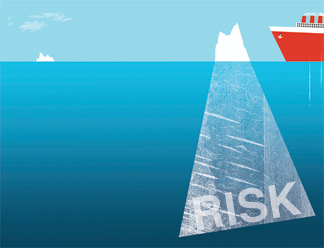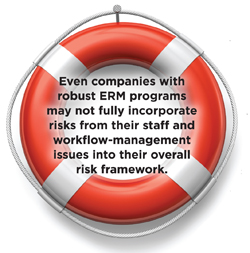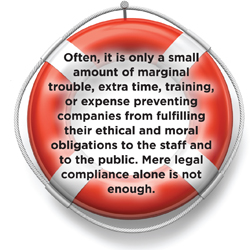 Editor's Note: This article has been contributed by DeniseTessier, senior regulatory consultant for Insurance ComplianceSolutions, ERM and the Consulting Practice at WoltersKluwer Financial Services.
Editor's Note: This article has been contributed by DeniseTessier, senior regulatory consultant for Insurance ComplianceSolutions, ERM and the Consulting Practice at WoltersKluwer Financial Services.
Last year marked the 100th anniversary of the first and onlyvoyage of the RMS Titanic. On Apri 15, 1912, the demise of the“unsinkable” ocean liner caused 1,502 fatalities, one of thedeadliest maritime accidents of all time. For more than a century,scholars have researched the many contributing causes of thedisaster, hoping to prevent future loss.
|This enormous ship was designed to be the “state of the art” insafety, with no expense spared by the White Star Line to ensurefirst class passengers the utmost in comfort and luxury. Yet, the“biggest and the best in the industry” failed miserably—a statementthat rings true in many industries, including insurance, today.
|As noted by risk expert Michael Rasmussen in his recent blogpost, “The Titanic: AnAnalogy of Enterprise Risk,” the lessons we learn from theTitanic can help us understand and make a case for enterprise riskmanagement (ERM) today. In particular, one of the most significantlessons learned from the experience bears frequent repeating:Never underestimate human capital risk.
|Human capital risk can be generally defined as a workforce'sability to achieve strategic business objectives. As confirmed in a2011 report by The Conference Board, “ManagingHuman Capital Risk: A Call for a Partnership Between EnterpriseRisk Management and Human Resources,” even companies withrobust ERM programs may not fully incorporate risks from theirstaff and workflow-management issues into their overall riskframework. Human resources (HR) issues also tend to be more siloedthan other parts of the business, and HR managers may not be fullyintegrated into ERM committees or strategy teams.
|Specific issues like continuity planning, or hiring staff fornew operations, may come into the spotlight from time to time.However, the depth and breadth of analysis of human capital risksin an ERM program, particularly for insurers, may be less thoroughthan for other risk areas such as underwriting loss or capitalplanning.
|Scoping Risk: Human Activities andAssets
Strategic, legal/compliance, and operational aspects of humancapital management must be thoroughly considered in an ERM programin order to develop a complete picture of risk to the company, andput into place necessary controls or systems to ensure that humanerror is either eliminated, minimized or supported by back-upplans.

Just a few examples of contributing causes to the Titanicdisaster show how both individual human error and staff or workflowmanagement, if not properly evaluated as part of personnel risk,can significantly affect results of any major operation:
|Several poor key strategic decisions were made.According to an inquiry by the U.S. Senate's Commerce Committee,the ship's speed was excessive, considering its size and steeringcapabilities. Neither Captain Smith, nor the White Star owner Mr.Isling, heeded three distinct warnings of ice flows in the vicinitysent by nearby [sources]. The Captain reasonably should havediscussed the warnings with other officers or placed additionallookouts on duty.
|Another major factor in the Titanic's sinking was its coredesign. Ship architects boasted that its multi-compartment designwas “watertight” because the bottom was double-walled, and exteriorsliding doors were sealed. However, water seeping from icebergpunctures could fill multiple compartments side-by-side, making thebase much heavier than anticipated. Also, the materials chosen forthe construction of the hull and rivets were of a metallurgybecoming brittle in icy water, making it easier for solderingrivets to pop out. Designers of the Titanic either were not awareof, or consciously chose not to implement, sounder buildingpractices that other vessel designers of that time had discovered.Risk managers must consider the fact that even the most up-to-datetechnology and operational practices are not foolproof, and thatsimple errors in judgment can still cause significantloss.
|Captain and crew may have had insufficient experienceand training. Another issue was that the Titanic crew hadnot been trained adequately in carrying out a full-scaleevacuation. Many did not know the fast escape routes to higherfloors, and there was a delay in getting lower-level passengers tothe deck. We also know that numerous officers were not told howmany people they could safely put aboard in the newly designedlifeboats. As a result, the crew launched many of the lifeboatsbarely half-full.
|Also of note, while Captain Smith was an experienced seaman, hehad not headed a ship of the size and complexity of the Titanic,and may have been missing crucial background knowledge about howquickly it might stop or turn, considering its speed and itsunusually small rudder size. Today, many companies still provideinsufficient attention and funding to education and traininginitiatives, often favoring investment in capital assets andtechnology. It's important, though, to consider the full range ofcosts and benefits of a state-of-the-art system or machine, ifstaff cannot use it properly.
| There were few standards governing work shifts,and so short-staffing caused problems.
There were few standards governing work shifts,and so short-staffing caused problems.
Onlytwo Marconi radio operators were on board to relay messages frompassengers via wireless radio, and the men were expected to simplywork around the clock, taking breaks and relieving each other onlyas one felt tired. There was evidence that one or both had receivediceberg warnings from local ships, but were either unwilling orunable to relay those messages to the bridge, or did not followproper procedures to recognize and transport messages to thebridge. Evidence later indicated the men were, in fact, inundatedwith Easter telegraphs to and from passengers and did not focus onthe warnings partly because of their general stressful workflow.Risk managers and HR professionals benefit from close cooperationin evaluating the wide range of potential problems that can arisefrom staffing shortages.
The Letter and the Spirit
Key men complied with the letter, but not the spirit, ofthe law. The ship's lifeboats had capacity to hold onlyhalf of those on the voyage, and merely a third of passengers andcrew if the ship had been fully-loaded. Because of outdatedmaritime safety regulations, this minimal coverage was sufficientfor the ship to be deemed “legally compliant.” Clearly there was amismatch in what was required as “safe” from a legal perspective,and what was truly necessary. Often, it is only a small amount ofmarginal trouble, extra time, training, or expense preventingcompanies from fulfilling their ethical and moral obligations tothe staff and to the public. Mere legal compliance alone is notenough.
The complicating factor of human “optimistic bias” mustbe considered. In a prior Property-Casualty360.com blog,“Rose-ColoredRisk: Reducing Bias in ERM Risk Assessments,” it was noted thathumans have a natural tendency or bias towards self-deception aboutsignificant risk, called “optimistic bias.” It proposes that peopleexpect things to turn out better for them than their peers, or thatthey expect that the future will be brighter and better than thepast.
|Optimistic bias of the owners, staff and crew was a keycomplicating factor in the poor evaluation of many of the Titanic'spotential risk areas. The Titanic experience demonstrates inextreme detail how an overly–but naturally—human optimistic view ofthe world can lead to one overlooking the small details that mightaffect measurements of the true likelihood and magnitude of risk.ERM practitioners must appreciate that all evaluation of riskitself is subject to human interpretation and bias, and adoptappropriate mitigation techniques to ensure a clear, sharp view ofthe future.
|Practical Solutions For Better RiskManagement
To begin tightening risk management aroundhuman capital, HR and ERM professionals must step up their effortsto catalog and fully assess the range of risks involving people.This includes both the risk of losses to personnel and staff, aswell as losses potentially caused by employees and mismanagement—anumber of scenarios that can be difficult, but not impossible, toquantify.
During this process, it may help to first categorize the lossesinto subcategories of risk, such as a.) strategic, b.) operationaland c.) legal/compliance risk, then assess the myriad riskscenarios found within the appropriate categories:
|1. Strategic human capitalrisks would include high-level business planning issues, suchas:
- Overall workflow and management design for delivery of thecompany's products and services.
- Identification of key personnel whose loss would affectstrategy of the company. This may refer to the CEO, CFO, or head ofa financially sensitive unit such as underwriting or claims.
- Constitution and charter of the board of directors and majorcommittees.
- Strategy decisions with major staffing impact, such as openingor closing a branch office, or creating a new product or entering abusiness line.
2. As for operational risks typicallyfaced on a day-to-day basis, considerations may include:
- Death, resignation, retirement or disability of key performerswhose contributions are key to business plan achievement. Anexample would be a top sales person.
- Overall staffing levels for departments, including turnover andretention.
- Large-scale layoffs or major departmentalre-organizations.
- Compensation issues, which could in turn affect turnover andretention for particular jobs.
- Training and education of staff to ensure core competencies injob skills.
3. Legal/compliance risks associatedwith employees, violation of which can incur fines, fees, penaltiesor spawn litigation against the company. Related issues mightencompass the following:
- Compliance with wage and hour laws, or hiring practices, suchas background checks.
- Training and education, as well as policies and procedures, toprevent sexual harassment, workplace violence, and discriminationof any kind.
- Ensuring employees follow regulatory compliance and safetyprevention policies and procedures.
- Implementing practices and controls to prevent theft, fraud,embezzlement, bribery, or other criminal acts.
Assessment Assistance
To this end,companies should take full advantage of the range of riskassessment tools available, including creating questionnaires andsurveys; reviewing personnel loss histories and workers'compensation claims records; interviewing managers and staff,reviewing flowcharts and organizational matrices; and conductingon-site inspections. In addition, HR professionals should have aclearly defined role in the ERM process, to assist the company inhaving a full and properly aggregated view of risks, root causes,interactions, and impacts of business strategy as it affects, andis affected by, the workforce.
Human capital risk comprises a significant part of the riskprofile of any major organization. The identification andmanagement of human capital risks in relation to business strategyshould not only be a core skill of every HR executive, but alsosuch skills and experience should be shared–and maximized–throughHR participation in the organization's ERM program. Don't letunidentified and unmanaged human capital risk sink your ship.
Want to continue reading?
Become a Free PropertyCasualty360 Digital Reader
Your access to unlimited PropertyCasualty360 content isn’t changing.
Once you are an ALM digital member, you’ll receive:
- All PropertyCasualty360.com news coverage, best practices, and in-depth analysis.
- Educational webcasts, resources from industry leaders, and informative newsletters.
- Other award-winning websites including BenefitsPRO.com and ThinkAdvisor.com.
Already have an account? Sign In
© 2024 ALM Global, LLC, All Rights Reserved. Request academic re-use from www.copyright.com. All other uses, submit a request to [email protected]. For more information visit Asset & Logo Licensing.








